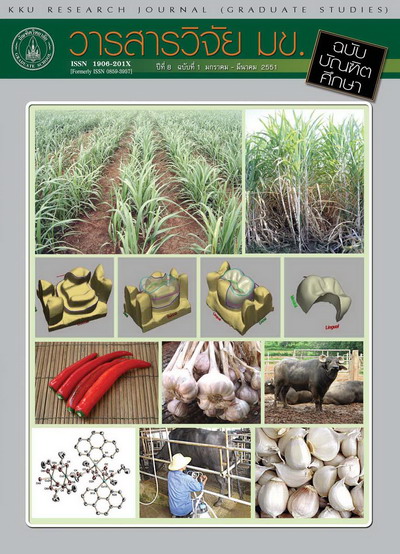Differential Flow Instability in Packed-bed Reactors in the Presence of Catalyst Deactivation(ความไม่เสถียรจากความแตกต่างของการไหลในปฏิกรณ์แบบอัดแน่นในสภาวะที่มีการเสื่อมสภาพของตัวเร่งปฏิกิริยา)
Keywords:
Catalyst deactivation(การเสื่ยมสภาพของตัวเร่งปฏิกิริยา), Differential flow instability(ความไม่เสถียรเนื่องจากกลไกการถ่ายโอน), Resonant amplification(ปรากฏการณ์กำทอน)Abstract
การทำงานในสภาวะที่ไม่คงตัวของเครื่องปฏิกรณ์แบบอัดแน่นส่งผลให้เกิดพฤติกรรมทางความร้อนที่แตกต่างกัน เช่น ลักษณะคลื่นความร้อนก่อนสิ้นสุดปฏิกิริยา (pre-extinction waves), ผลของการกำทอน (resonance effect), การเคลื่อนที่อย่างช้าๆ ของบริเวณที่มีความร้อนสูง (creeping thermal front) การเสื่อมสภาพของตัวเร่งปฏิกิริยาก็มีส่วนร่วมในการขับเคลื่อนให้เกิดลักษณะของระบบดังกล่าว จึงได้มีการทดลองจำลองปฏิกิริยาคายความร้อนอันดับที่ 1 ในเครื่องปฏิกรณ์แบบอัดแน่นและแบบจำลองการเสื่อมสภาพอันดับที่ 1 โดยปรากฏการณ์การเคลื่อนที่บริเวณอุณหภูมิสูงภายในปฏิกรณ์ (moving hot spot) เกิดขึ้นที่การเสื่อมสภาพอย่างช้าๆ และลักษณะคลื่นความร้อนก่อนสิ้นสุดปฏิกิริยาร่วมกับอุณหภูมิสูงเป็นผลมาจากการเสื่อมสภาพอย่างรวดเร็ว ลักษณะโครงร่างของตัวกระตุ้นในเครื่องปฏิกรณ์บ่งชี้ว่าการเสื่อมสภาพของตัวเร่งปฏิกิริยาไม่เป็นรูปแบบเดียวกันตลอดทั้งปฏิกรณ์Unsteady state operation of packed-bed reactors can result in different thermal behaviors such as pre-extinction waves, resonance effect, creeping thermal front. Catalyst deactivation also contributes to the dynamic features of such systems. A first-order exothermic reaction in a packed-bed reactor and a first-order deactivation model were simulated. Moving hot spot occurs at slow rates of deactivation. The activity profile indicates that catalyst deactivation is not uniform throughout the reactor bed. Pre-extinction waves with high temperature result from fast deactivation. Imposed inlet temperature oscillations were found to be amplified to a greater extent with the presence of catalyst deactivation.



